If you’re an avid birder, sometimes it’s fun to get a little creative with your spotting checklist, and if that’s the case then we have a treat for you today. In this article we’re going explore some yellow-breasted birds that you can add to your list and keep an eye out and we’ve tried to diversify a bit to keep things interesting.
Types of Yellow Breasted Birds
Without further ado, let’s take a closer look at some amazing birds out there with colorful yellow breasts!
Audubon’s Oriole – Icterus graduacauda
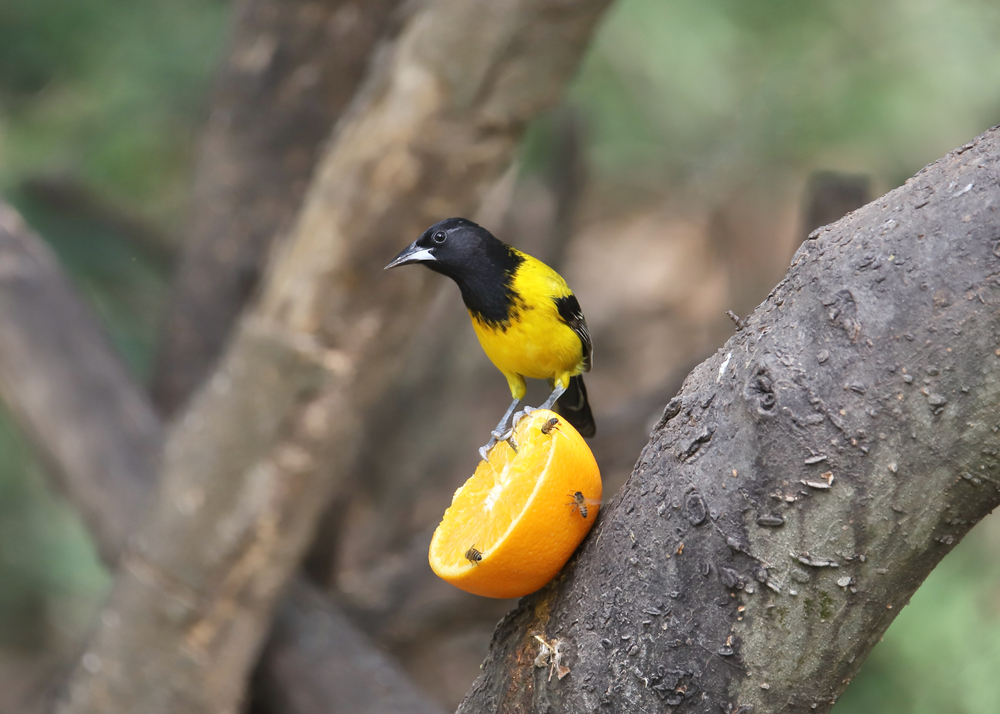
Coloration and Markings: Audobon’s Orioles are quite the sight. These birds have a bright, almost rubbery yellow on their backs and their shoulders, with the lower portion of their medium-length wings being black with white highlights. These birds have long, black tails, with minor white highlighting, and their rump, belly, and breast are the same bright yellow, though some black will come from the throat and bisect the yellow breast. Facially, these birds are black, and they have long, very pointy black bills with a slight hint of curve and sometimes a little grey in the bottom half of the bill.
Size: These Orioles measure 7.5 to 9.4 inches in length, with a wingspan approximately 12.6 inches wide.
Diet: Audobon’s Orioles eat various insects and are especially fond of their larvae, though they also enjoy fruits and berries as they find them. They also like a bit of nectar and you might catch one in your Hummingbird feeder, if you’re having a lucky day!
More about the Audubon’s Oriole
While mostly found in Mexico, these birds do seem to love southern Texas, as well, but they are a bit on the shy side and tend to spend their time in the woods or foraging in dense bits of brush. After mating, these birds tend to produce between and 5 bluish-white and dark-streaked eggs, but they don’t always get to keep all of them.
As it turns out, Audobon’s Orioles are a favorite target of Cowbirds, who like to add some eggs of their own to the nests. Statistically, more than HALF of the Oriole nests out these have had an unwelcome Cowbird visitor, and while they are not considered endangered their populations have seen a small, but noticeable decline.
Yellow-throated Vireo – Vireo flavifrons
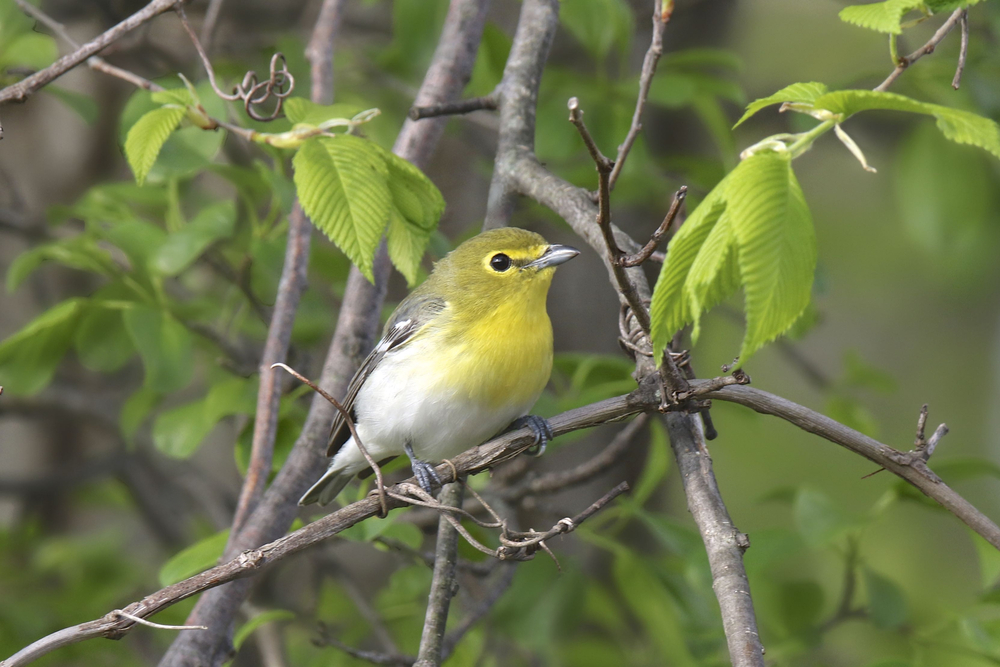
Coloration and Markings: Yellow-throated Vireos have grey backs, with medium-length grey wings which sport two white wingbars (often with almost black coloration beneath them), as well as short, grey tails. The underbelly of this bird is white, while the breast is a mix of white and yellow that comes down from the bird’s throat. Facially, these birds are a grayish-yellow, with bright-yellow spectacles and throat, as well as a thin, grey eyeline that may terminate or extend a little past the eye. These birds have short, conical black bills.
Size: These birds measure in at 5.1 to 5.9 inches long, with wingspans of approximately 9.1 inches wide.
Diet: Yellow-throated Vireos eat a wide variety of things, such as stinkbugs, beetles, moths, spiders, bees, and even seeds and fruits when they stumble upon them.
More about the Yellow-throated Vireo
Found in eastern North America, the Yellow Throated Vireo likes warmer climes for winter, moving to south and central America when it gets chilly and whiling away their time in coffee plantations and beaches. When mating, these little guys and gal eschew aerial escapades, with the males instead shaking their wings quickly and swaying to get the attention of potential mates after hedging their bets – by waiting around with nesting materials which they have gathered for the females.
If the female is impressed, then they’ll build a nest together, and soon they’ll have 3 to 5 eggs to watch for a period of roughly 2 weeks before they’ll hatch and the cycle of life begins anew.
Western Tanager – Piranga ludoviciana
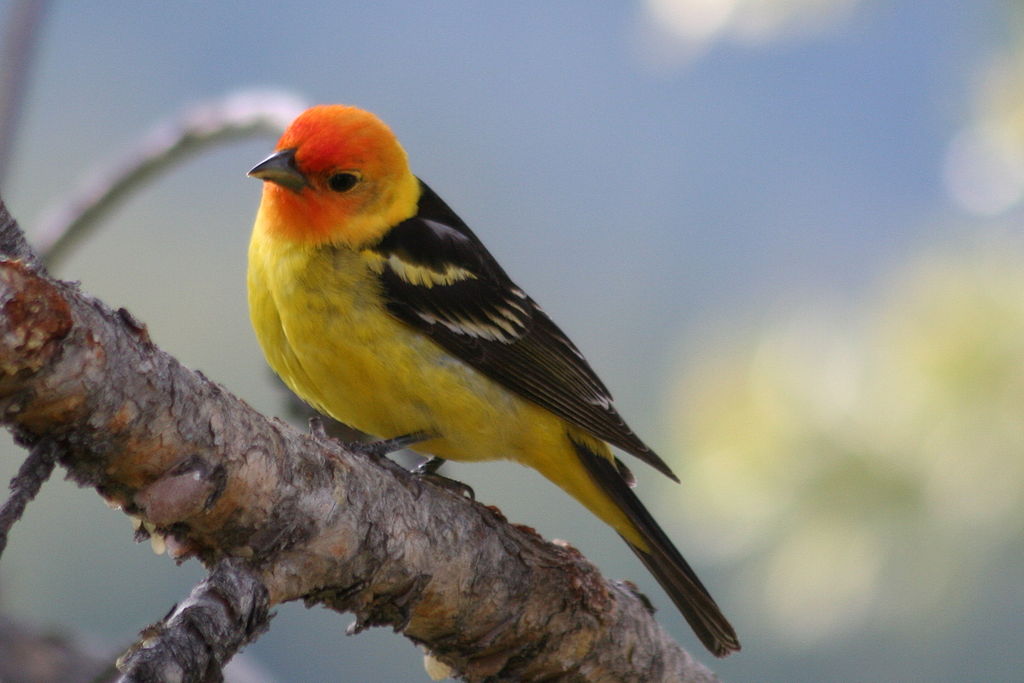
Coloration and Markings: Western Tanagers have grey backs, with medium-length grey wings which sport two wingbars – one yellow on the upper portion of the wing, and a white one below. That have medium-length, split tails with are grey with some yellow on top, and completely yellow below. The underbelly and breast of this bird is a mix of whites and yellow, while facially the females are a ‘dirty yellow’, with a purer yellow framing the underside of the cheek, and males are a fiery mix of red and yellow! These birds have medium length bills that are yellow or gray on top and yellow below, and straight with a slight curve at the sharp tip of the bill.
Size: These birds are 6.3 to 7.5 inches long, with wingspans averaging about 11.5 inches wide.
Diet: Western Tanagers like to eat termites, wasps, grasshoppers, and while they tend to turn their bills up to seeds, they do like dried and fresh fruits from time to time to sweeten up their day.
More about the Western Tanager
A lot of birds out there get their fancy red coloration by eating plants that contain cartenoids (such as pumpkins or sweet potatoes), but not so for the Western Tanager. While we haven’t narrowed it down to the specific insect, it is believed that some of the juicy bugs that they eat regularly are the source of the Tanager’s own facial flame.
If you’re looking to see one of these birds, you’ve got a lot of locales where you can spot them, as they are known to be present at various times of the year in Canada, throughout North and Central America, and specifically in the states of Texas and Nebraska.
Yellow-Bellied Siskin – Spinus xanthogastra
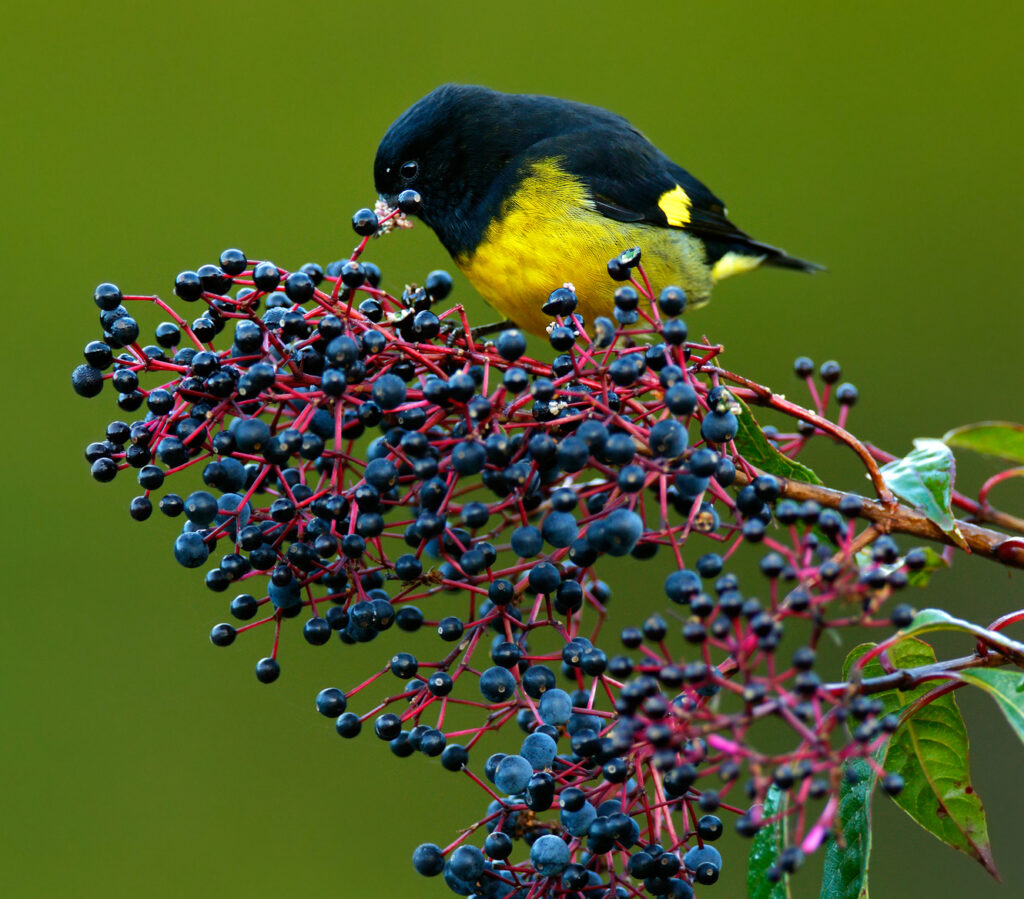
Coloration and Markings: Yellow-bellied Siskins have black backs, with medium-length black wings which sport a bright yellow patch on each, and short, forked black tails. The rump and belly are a lovely bright yellow that matches their wing patches and facially, they are jet-black as well, with the coloration going down their throat like a hood and creating a black v in their bright, yellow breast. These birds have short, stout black bills with a noticeable, if slight, curve to them.
Size: These tiny birds average around 4.1 inches in length and have wingspans of 7.1 to 8.7 inches.
Diet: Yellow-bellied Siskins like to eat leaves, seeds, and the occasional berries, although they also round-out their diets with just about any small insects that they can find.
More about the Yellow-bellied Siskin
These exotic members of the passerine Finch family like to breed in high-altitude forests of oak and are found in North America in Panama and Costa Rica, as well as in South America where you’ll find them in Bolivia, Colombia, Ecuador, and Peru. They tend to find safety in numbers, travelling in flocks of around 30 birds each, although when they are not in protected areas they are highly sought-after for capture to be sold into the pet trade.
Even though they only produce 2 to 3 eggs, they are apparently good at avoiding capture, falling into the ‘least concern’ category as far as their numbers today.
Townsend’s Warbler – Setophaga townsendi
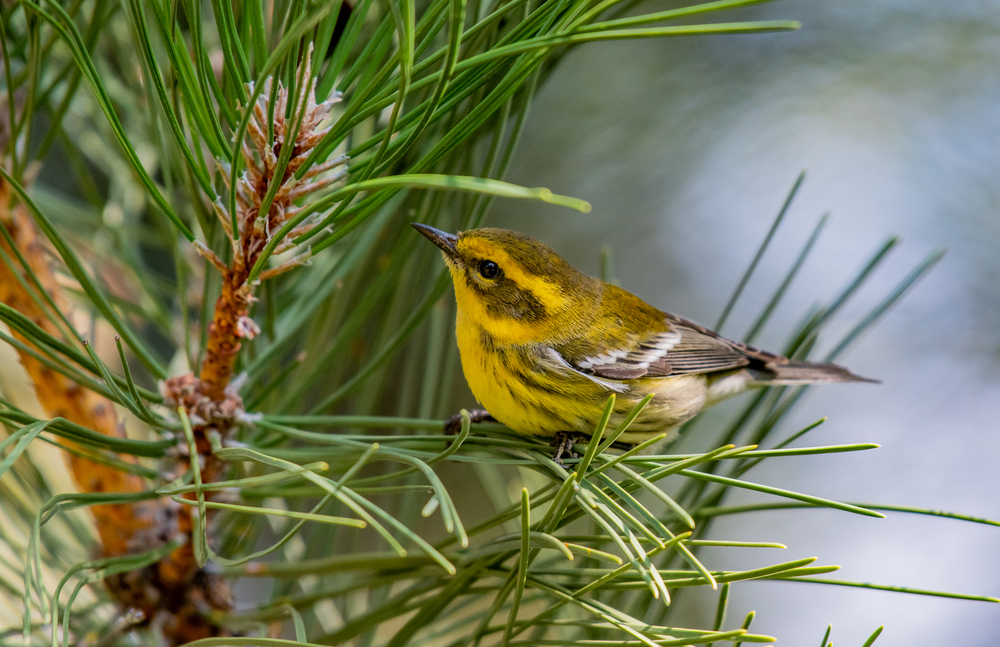
Coloration and Markings: Townsend’s Warblers have yellowish backs, spotted with black, and this yellow and black extends up into the shoulders of the wings. Said wings are an interspersed combination of greys and blacks, with two large, white wingbars present. They have short, perky, grey and black tails and the belly of this bird is white with black streaking, which changes to yellow with black streaking towards the breast. Facially, this bird is bright yellow, with a long, black cap and black at the throat, as well as a black mask with a yellow patch often present under the eye. These birs have short, sharp, and conical black bills.
Size: Tiny and cute, these Warblers measure in at 4.7 to 5 inches in length, with wingspans of 7.5 to 8.3 inches wide.
Diet: Townsend’s Warblers absolutely love caterpillars, but they’ll also eat moths, beetles, bees, and even stinkbugs from time to time. They also enjoy seeds and when it’s migration time, you’ll catch them supping on nectar from the occasional flowers that they find along the way.
More about the Townsend’s Warbler
While a flock of Townsends is often referred to as a ‘bouquet’, they are also called a ‘confusion’, and as they travel in flocks of 20 you can certainly see why if you try to keep your eye on of the bouncy and beautiful little birds. You can find them in the United States Pacific coast, as well as in Central America and Mexico.
Interestingly enough, when they are in Mexico their diet becomes very specialized, as they seem to favor local scale insects which produce a sweet and sugary secretion called ‘honeydew’ that they can’t seem to get enough of!
Orange-Crowned Warbler – Vermivora celata
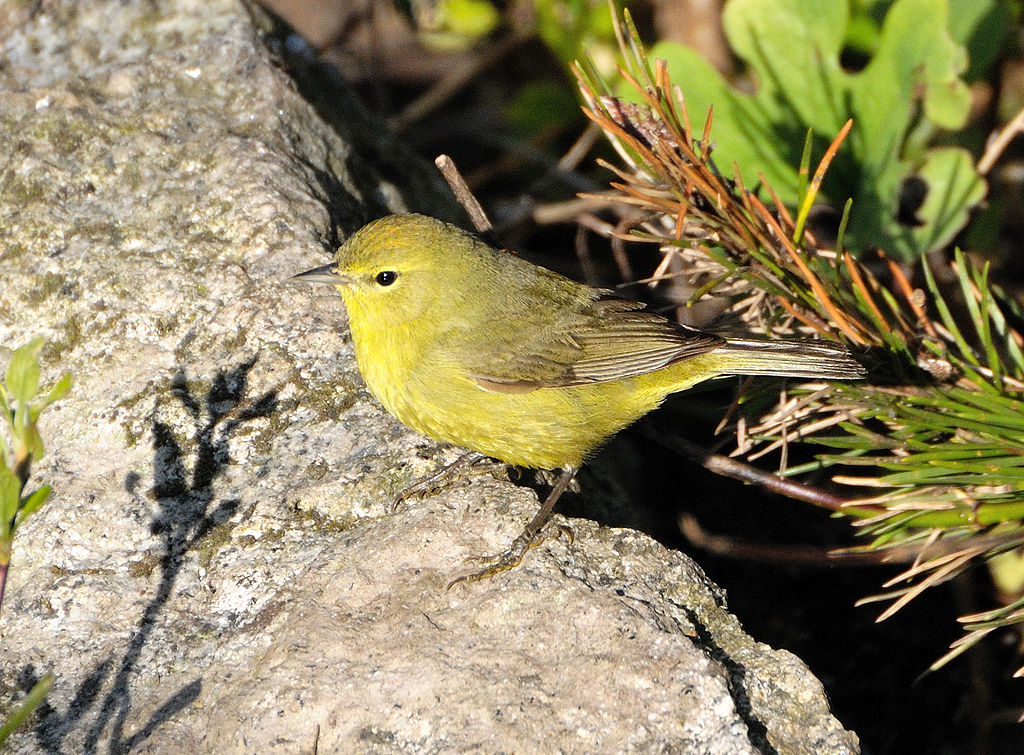
Coloration and Markings: Orange-crowned Warblers have yellowish-gray or olive-gray backs, with medium-length greyish wings that sport a little ‘dirty yellow’ patch at each shoulder. They have medium-length gray tails with white highlights and which sport yellowing coverts underneath and the belly of this bird is mostly white, with a small amount of yellow that increases in density as it moves up the breast. Facially, these birds have greyish faces, with gray and yellow chins, and a black eyeline that starts from the bill and terminates a little behind each eye. The Orange-crown is present, but small, and these birds have long, black and grey bills with a slight curve towards the tip.
Size: These little guys and gals measure about 4.3 to 5.5 inches in length, with wingspans approximately 7.5 inches wide.
Diet: Orange-Crowned Warblers eat insects, though mostly they prefer to eat insects in their larval stage. They supplement this diet with berries, sap from abandoned woodpecker or sapsucker foraging spots, and plant nectar, as well. They also have a fondness for peanut butter when it comes to feeders, so use that as you will.
More about the Orange-Crowned Warbler
Breeding in Alaska and Canada, Orange-Crowned Warblers are also fond of the southern United States and also Central America. These hardy little birds, it should be noted, quite often choose to winter in the United States and in large numbers – a handy little option due to their love of berries and sap, which they’ve become quite adept at finding when it’s chilly outside!
They also come in a variety of sizes and colorations, as there are 4 distinct subspecies of these birds, and the West Coast variety tend to have the most brilliant orange in their crown – though you won’t see it unless the bird is surprised out looking for a mate!
Lesser Goldfinch – Spinus psaltria
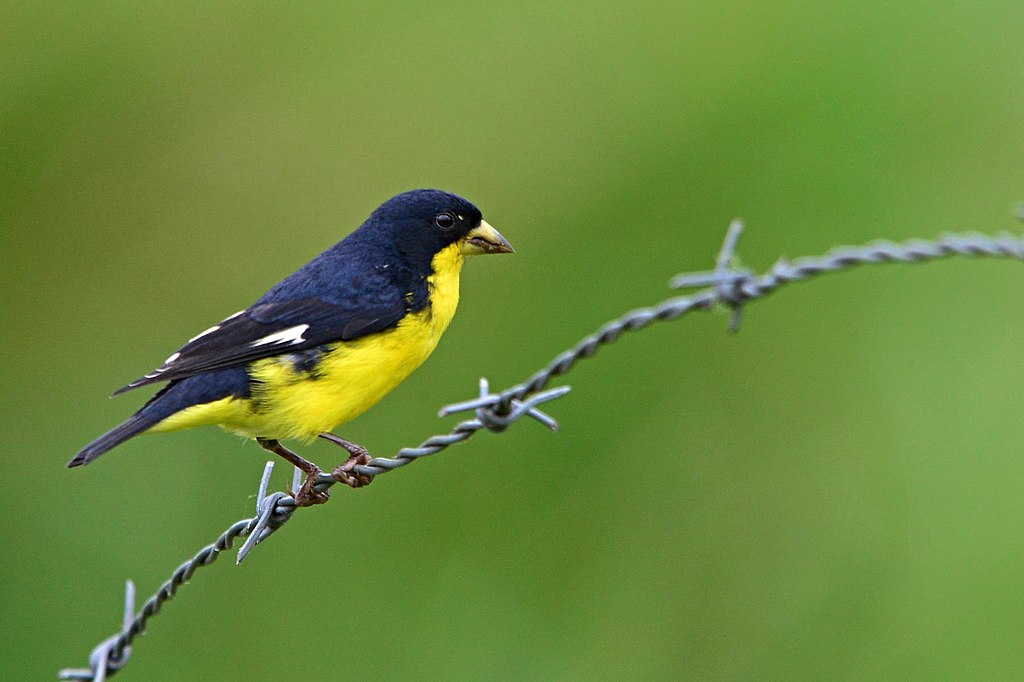
Coloration and Markings: Lesser Goldfinches have rather glossy black (occasionally even a muted green) backs and medium-length black wings, which sport the occasional white patches, and short, black tails with white corners. The rump, belly, and breasts of these birds are a beautifully contrasting bright yellow, that carries up into the face to cover the throat and thread up until it’s level with the underside of the top half of the bill, leaving the rest of the face black rather like it’s wearing a hood-style mask. These birds have stout, short, and conical bills that are yellow with splotches of gray present.
Size: These birds measure a very diminutive 3.5 to 4.3 inches in length, with wingspans of 5.9 to 7.9 inches wide.
Diet: Lesser Goldfinches might eat an insect, but only by accident, as they prefer to eat seeds, grains, and the occasional yummy fruits that they stumble on from time to time.
More about the Lesser Goldfinch
You’ll find the Lesser Goldfinch in the western United States, most commonly in California or Texas, though these little birds are also spotted just south of central Mexico and even as far as the Peruvian Andes! They also tend to be bullies when it comes to their cousins, the Lawrence Goldfinches, and when observed at feeders the Lawrence variety will always wait until the Lesser Goldfinch has eaten their fill before they attempt to snack a little themselves. This is just typical bird behavior, however, as the Lesser Goldfinches are bullied in turn by other birds they’ll flock around, such as White-crowned and Lark Sparrows.
Couch’s Kingbird – Tyrannus couchii
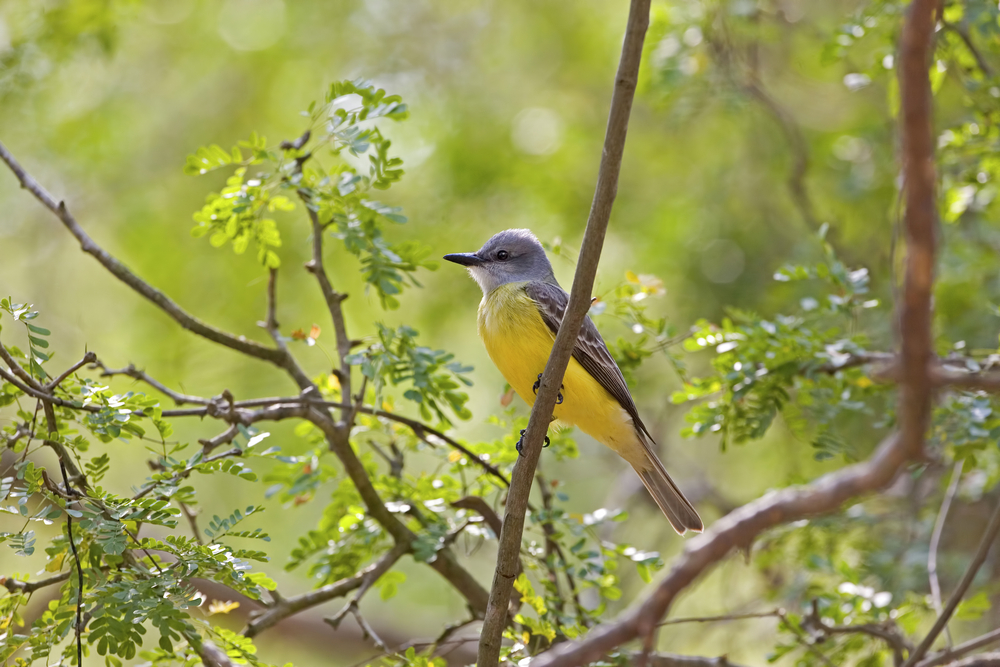
Coloration and Markings: The Couch’s Kingbird is mostly grey, with a light to medium grey on it’s back, and medium-length, grey wings with some pleasant white outlining present in their display. They have medium-length grey tails, with a little white highlighting as well, and their rumps are a layer of pure white on top, with a bright yellow underneath that extends up to the belly and through to the breast. Facially, these birds are a pel, almost bluish grey, with a grey mask that is lighter grey above and darker just below and behind the eyes. They also have pure white underneath the chin, which descends down a little into the breast and these birds have long, straight, and medium length black bills.
Size: These birds have an average overall length of approximately 9 inches, with wingspans of about 16 inches wide.
Diet: Couch’s Kingbirds like to eat fast-food in the form of flying insects, which make up most of their diet. When they aren’t munching on insects, they supplement their diets with occasional yummy fruits and berries.
More about the Couch’s Kingbird
In the United States you’ll want to look for these birds in their favorite place – Southern Texas. You can find them here year-round, though they may also be found in places like Mexico, Northern Guatemala, and in Belize. When these birds hunt, it’s typically a matter of perching in place and launching into flight to intercept some very surprised flying insects, and another interesting fact about these birds is that they like to recycle.
When building nests, they’ll use materials from previous nests in their construction, though if new components are required then you’ll see them ‘hovering’ in place while gathering up new nesting materials as-needed.
Great Kiskadee – Pitangus sulphuratus

Coloration and Markings: Great Kiskadees are quite colorful birds. Their backs are brown to reddish-brown and they have long, rounded wings of dark brown with reddish-brown highlights and patches present. They also have medium-length, squared-tipped tails which are reddish brown as well. The belly and breast of this bird are a lovely Canary yellow and facially, they look like many Woodpeckers, with white face and throat, along with a black cap and a thick, black mask band, to go with a lonh, stout, and conical black bill.
Size: These good-sized birds measure in at 9.8 to 11 inches in length and have wingspans approximately 16 inches wide.
Diet: These omnivores enjoy insects, as well as small reptiles, mice, frogs, fish, and the occasional unlucky baby bird! They also enjoy seeds, fruits, and berries, so they have a wide variety of choices when it comes to dinnertime.
More about the Great Kiskadee
Found in southern Texas and further south into Mexico and all the way to Argentina, the Great Kiskadee is a beautiful bird that is as bold as it is colorful. When their nests are threatened, they’re more than willing to attack and attempt to chase off animals such as snakes and even monkeys – which is pretty darned impressive, when you think about it.
They also happen to be members of the Flycatcher family and one of the largest Flycatcher’s to boot! Those thick, black bandit masks of theirs also serve a practical purpose, as they reduce glare and allow these birds to hunt sparkling waterways or in open areas where the bright light might otherwise make for difficult foraging.
Bold, big, and beautiful, our final fun fact is that they eat a little escargot from time to time – as they tend to find and gobble up snails as part of their foraging behaviors. If you happen to spot one, be sure to take a picture, as this is definitely a bird you’ll want to remember!
Yellow-Breasted Chat – Icteria virens
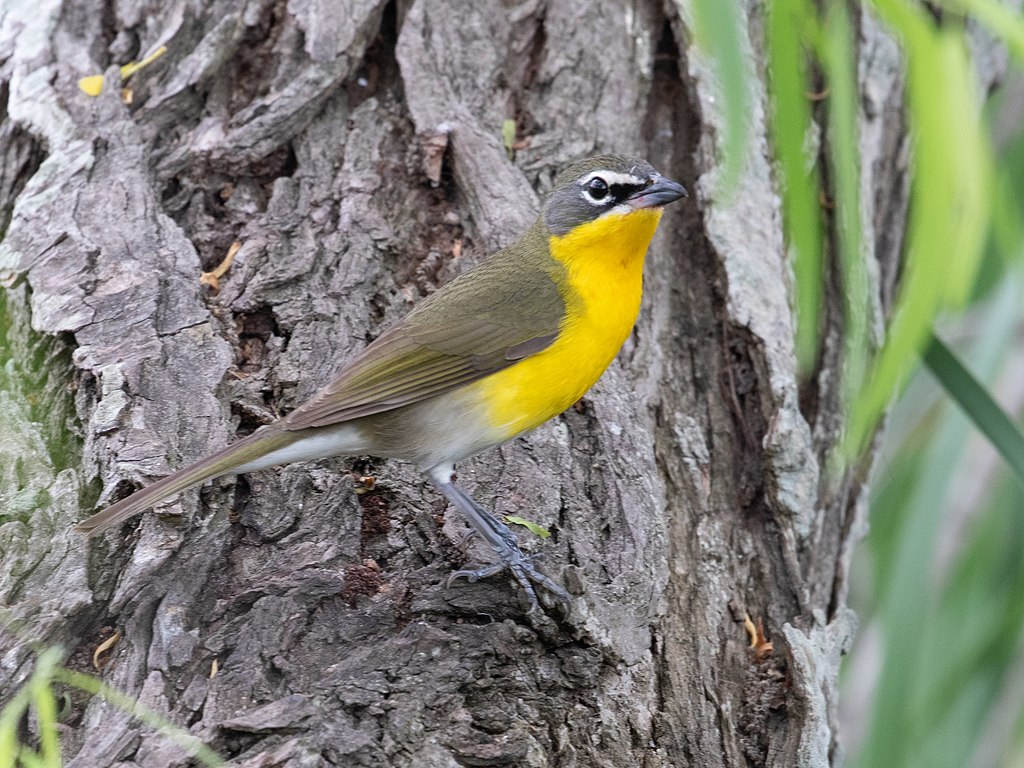
Coloration and Markings: The Yellow-Breasted Chat has a soft grey back, with small wings that are grey at the shoulders, but which have grey and olive coloration for the remainder of their length. These birds have long, grey tails with some minor white highlighting and while their rump and belly are snowy-white, they have brilliantly yellow breast coloration above them. Facially, these birds are a lovely grey, with white spectacle lines curling around the eyes and white mustache lines just above their throat of brilliant yellow. These birds have medium-length, lightly curved bills that are solid black or sometimes a mix of black and a little white.
Size: These birds measure around 7.1 inches long, on average, and have wingspans of approximately 9.8 inches wide.
Diet: These birds eat a balanced diet, consisting of insects as small as ants to as large as beetles, along with berries and other fruits that they find in the wild – although they are especially fond of blackberries and grapes!
More about the Yellow-Breasted Chat
The largest Warbler around, you can find the Yellow-Breasted Chat throughout North America, although they like to winter in Central America to stay as warm as possible throughout the year. Like other yellow breasted birds, Chats have the occasional problem of sneaky Cowbirds getting into their nests and laying their eggs, but they’ve adopted an increased range that helps to minimize the effectiveness of the Cowbird’s favorite trick.
They can also do something that other Warblers cannot – they can mimic the calls of other birds. This makes it harder to find them, but they do have their own distinctive ‘chak!’ call that you will hear from time to time, so try to listen for that if you are looking to spot once of these birds in the dense, thicketed areas which they like to frequent.
Some final words on Yellow-Breasted birds
So, there you have it! We hope that you’ve enjoyed our little exploration into the world of yellow-breasted birds and while we’ve barely scratched the surface, these beauties are a great way to start a list of your own that you can certainly build on. Just be sure to bring some non-crunchy snacks and your camera along with you when you do and to share those photos afterwards -we can’t wait to see what you find!
